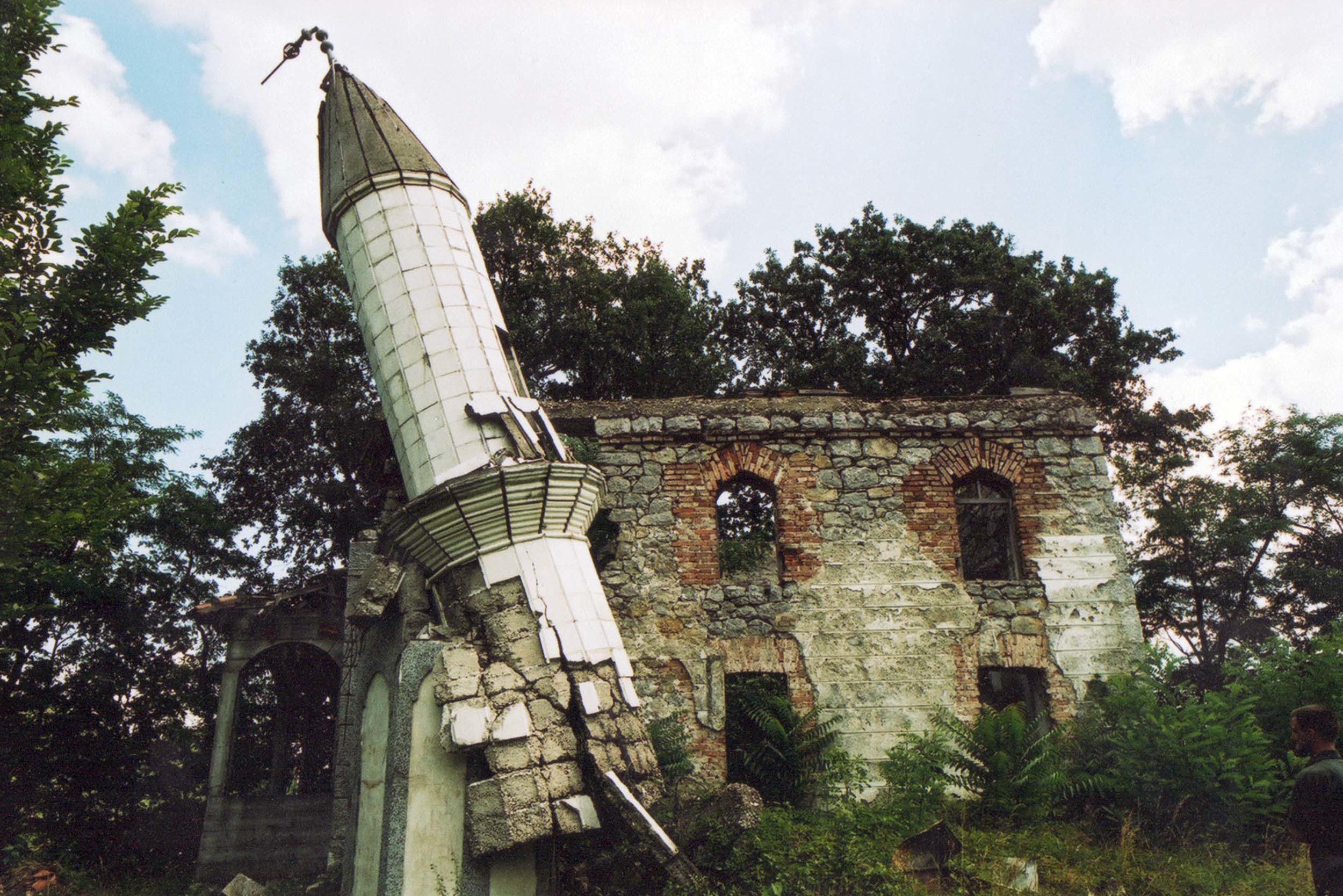A Life Worth Living
Azra Akšamija explores the complex role of culture in war and other crises.
May 24, 2022
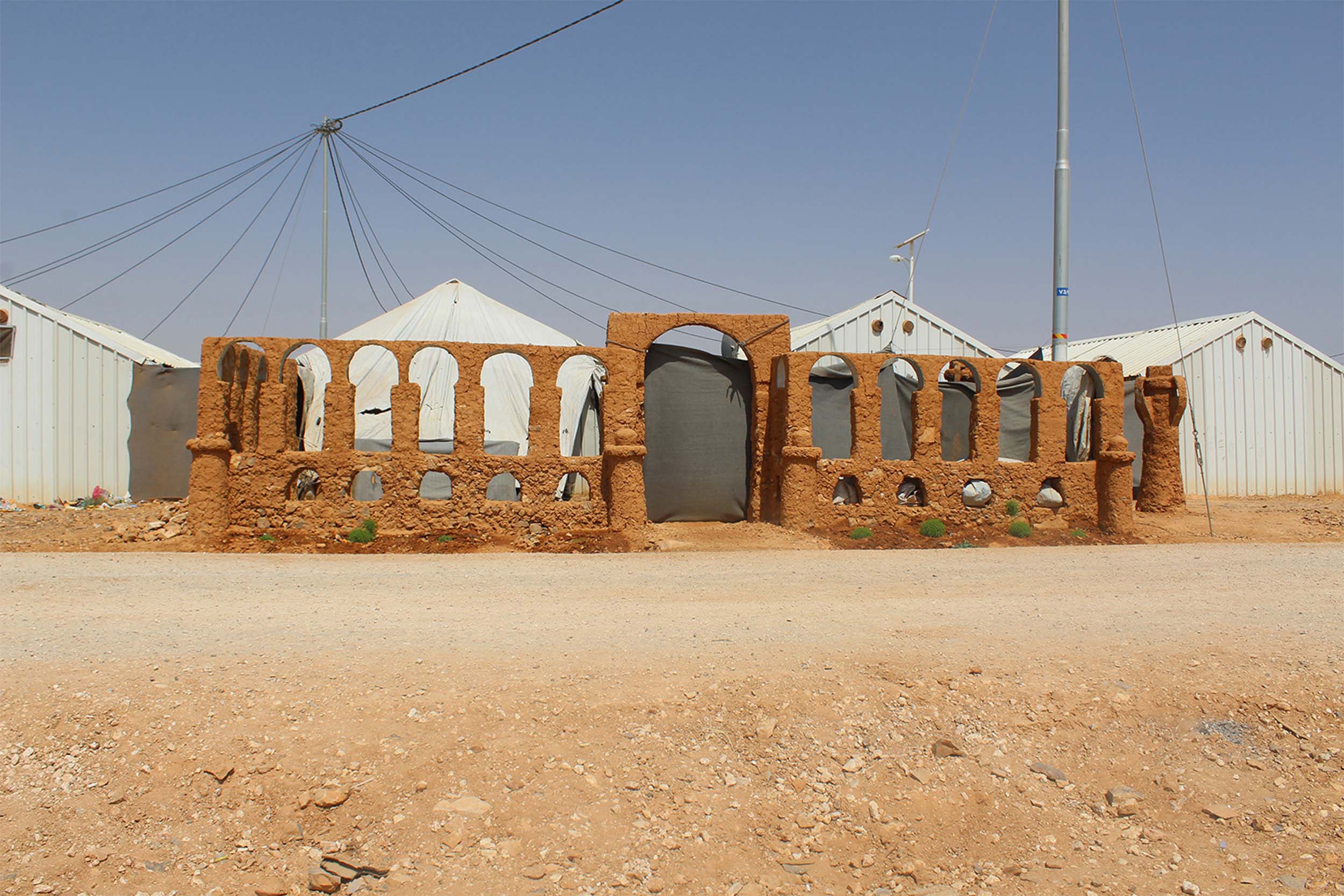
As part of their work at Al Azraq Refugee Camp in Jordan, Akšamija and her collaborators at MIT's Future Heritage Lab documented a refugee-built sandcastle designed to resemble the Arch of Triumph in Palmyra, Syria, which was destroyed by ISIS in 2015. Image credit: Future Heritage Lab
In life-or-death scenarios like war and forced migration, architecture and other cultural phenomena would seem to be at most marginal concerns. But as the work of Azra Akšamija demonstrates, culture can be used both as a powerful weapon and as a tool to empower the vulnerable. As an artist, designer, and architectural historian, Akšamija has spent her career reflecting on these issues. The League’s Alicia Botero and Sarah Wesseler spoke with her about her work.
*
Sarah Wesseler: Can you tell us about the development of your interest in using art and design to address conflict and crisis? How has your engagement with this theme evolved over time?
Azra Akšamija: My engagement with this topic is driven by my personal experience of war in Bosnia, going from happy life and coexistence to the destruction of everything I knew and the shock of a whole society turning into enemies. It was something that affected me not just on an emotional and personal level, but in terms of intellectual curiosity. I wanted to understand how it is possible that the power of ideology and nationalism can be stronger than your personal experience and your connections with family members and friends.
This is what happened in Bosnia, and especially in Sarajevo, my hometown, in the ’90s. When the war came, people turned on each other—the husband would leave the wife and go up the mountain to shoot at his own family and friends. I wanted to understand why and how this happened.
And since I was interested in art and design, I was particularly struck by how culture was weaponized during the war in Bosnia. I wanted to understand what about architecture and culture was so powerful in the eyes of warlords. Seeing the destruction of architecture gave me an understanding that these are powerful tools to turn people against each other, eradicate their history, uproot them, and also humiliate them.
So during my PhD here at MIT, I focused on the destruction of architecture during the Bosnian war, focusing particularly on the genocide against Bosnian Muslims. What I uncovered was that it was systematic, purposeful, and deliberate. It also happened on a really large scale: More than 1,400 mosques were largely or completely destroyed in Bosnia, as opposed to 200 Catholic churches and a smaller number of Orthodox ones.
And the targeting of architecture went beyond just pure destruction. It was really about humiliation and sadism toward architecture: The way you torture buildings parallels the way you torture people. These are heavy subjects, but it’s important to understand the weight and the potential of this issue. Why would someone take the trouble to plant bombs, shell a particular historic building, then do days and days of labor to excavate the rubble and even the foundation stones and carry them to an unknown location and bury them?
This kind of violence demonstrates the power of architecture, as a form of cultural heritage, to reframe history, and to reframe ways in which people think about their relationship to land and to each other. In Bosnia, the motivation was twofold: on the one hand, eradicating any evidence that a peaceful coexistence was actually possible and predominant in the region, and on the other hand, alienating people to such an extent that they never want to live together in the future. Because when someone has destroyed your mosque or church, raped you in front of it, crucified your imam, killed your entire family, how will you ever return to that village and live there with those people?
But even in that misery we saw the ways in which people rebuild things from scratch. Even in the middle of grenades and bombing, people were coming together to organize exhibitions, go to the cinema, put makeup on, do sculptures and interventions in public space—all while they have nothing to eat. Dževad Karahasan, a famous Bosnian writer, writes about a man who’s going to rescue the stones of the mosque when grenades are shelling around, and somebody asks him, “Why are you doing this? You’re gonna die!” and he says, “Would my life be worth anything if I wouldn’t rescue the stones?” So there’s something about this essential act of constructing and creating as a way of feeling like a human being, creating identity and relationships, and countering the power of destruction.
"There's something about this essential act of constructing and creating as a way of feeling like a human being, creating identity and relationships, and countering the power of destruction."
These were huge lessons for me. It took me years to understand them—and also to understand the origins of the war. In the ‘90s, journalists were telling us that the root cause of the violence was ancient hatreds among the “wild” Balkan people. But in reality, it was the result of manipulation by different economic and political interests, some of which were major external powers. They were the ones who pushed people into the trap of nationalism and religious extremism.
My family and I were fortunate to escape to Austria just before the beginning of the war, and that experience of exile and migration was also really telling. On the one hand, you’re experiencing the destruction of everything that you know—you know, your grandmother is hiding in the basement and your friends are dying. And meanwhile, you’re in this safe, beautiful place where everyone is going on with their beautiful lives. So that theme of how you can exist in one part of the world and not care about what’s happening in other parts is quite a deep wound that I had to deal with.
At the same time, being a Muslim woman coming from Eastern Europe into Western Europe, I experienced continuous cultural biases—not always evil ones, but you could just see that there are cultural differences, assumptions, and knowledge gaps. I realized that I was constantly put in this box with radical, fanatical people who have nothing to do with my own affiliation.
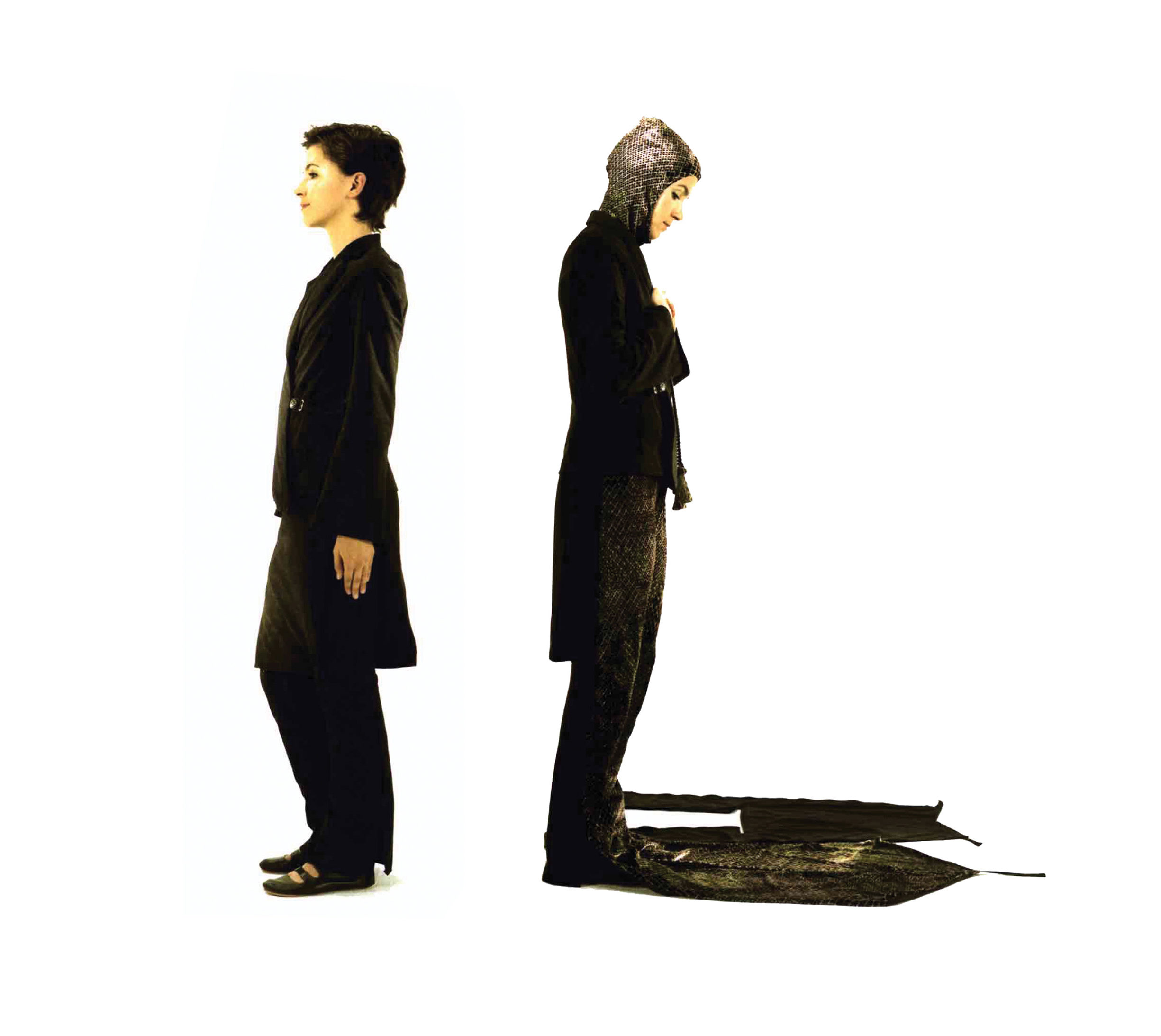
Responding to the marginalization of Muslims in many parts of the world, Akšamija's Nomadic Mosque project created clothing that transforms into prayer rugs, allowing any space to become a place of worship. Image credit: Jörg Mohr
And architecture played a prominent role in how this bias was manifested. For example, when Muslim migrants in Austria—or anywhere in Western Europe, really—want to build their mosque, they’re oftentimes not allowed to construct it. It’s always the same reasoning: “This doesn’t fit into our regional architecture.” “Ah, you cannot project sound and the call for prayer.” “Ah, this is too high; the minaret cannot be higher than the church.” So I experienced firsthand how architecture and urban planning can determine who has the right to be visible in public space.
A lot of my work related to Islamic representation in the non-Islamic environment deals with these questions. There are the wearable mosques, for example, or the prayer space for the first Islamic cemetery in Western Austria. These projects create visual arguments that deconstruct specific ideas of identity—the notion of Islam or the West or the East as these homogenous cultural entities—to show how identity is individual, local, constantly in flux, and that there is a possibility of being a hybrid, being contradictory and messy.
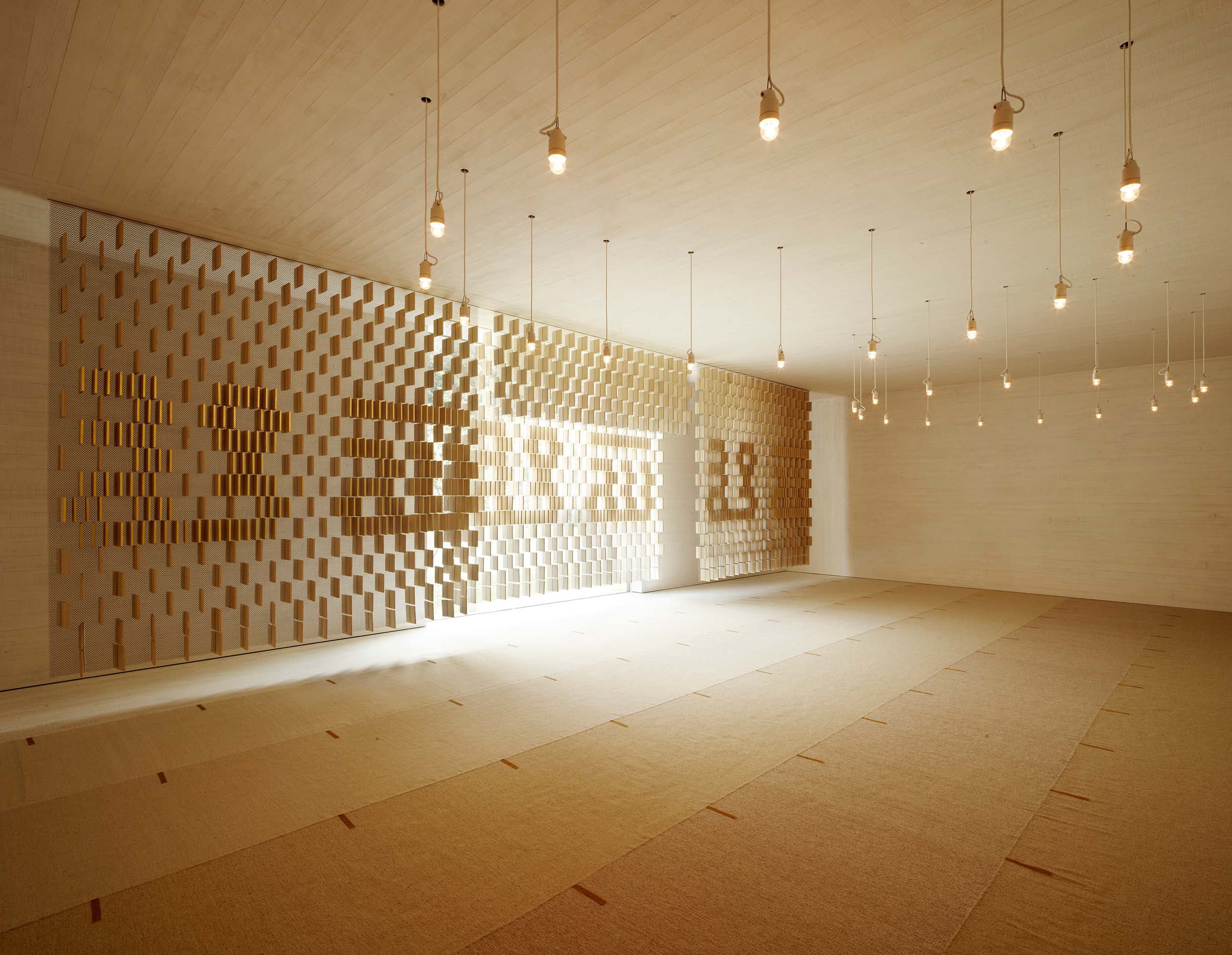
The Islamic Cemetery Altach provided a unique service to Muslim communities in the Austrian state of Vorarlberg when it opened in 2012. Akšamija was commissioned to create an artwork for the prayer space, complementing the work of Austrian architect Bernardo Bader, who was responsible for the cemetery complex. She has described her design as "guided by the idea that Muslim immigrants in Vorarlberg would see the cemetery as a testament to the fact that Austria was their homeland and the place where their dead rested." Combining local materials such as wooden shingles with architectural elements drawn from Islamic religious traditions, the project reveals the connections between cultures often perceived as separate. Image credit: Adolf Bereuter
And then in 2016 I started the Future Heritage Lab at MIT. It’s a network of people who work through the lens of heritage with methods of contemporary art—participatory processes, for example, but also craft and certain translations of cultural forms—to address the needs of people who are under threat, like refugees. We investigate what these needs are and how are they being met, and also address the destruction of cultural heritage and memory.
That year, 2016, was the 100th anniversary of MIT moving from Boston to Cambridge. The school put out a call for installations, and I proposed a project called Memory Matrix, a large-scale installation that looked like Palmyra Arch, which had just been destroyed by ISIS. The proposal was accepted and I invited students to help develop it; over 20 different units and departments participated. It became a temporary, collective monument that functioned as an exhibition in which individual authors had authorship and agency through the design of little pixels that tell stories of artifacts and monuments that were destroyed during their lifetime. The 20,000 little pixels assemble into this larger matrix, which reveals an image of Palmyra Arch, but that image is kind of deconstructed.
One point of the project was to critique the role of images in cultural warfare. When Palmyra was destroyed and people around the world were publishing and sharing images of the destruction, we were all replicating this destruction through imagery, in a way. Collectively, we enhanced the power of what these images were meant to do, which was shock the Western world. These images were made for Western audiences, for our consumption: ISIS planted the bombs really carefully, they choreographed the whole thing. Everything was recorded, pictures were taken, and everyone was shocked. So we basically played into their hands.
The project was also a critique of technology and preservation discourse, because right after Palmyra was destroyed, Aleppo was as well, and no one in the West cared to the same extent that they cared about Palmyra. Even though Aleppo was also a World Heritage site, maybe we cared more about Palmyra Arch because we felt that it wasn’t only related to Islamic society—there’s Roman stuff, transcultural heritage.
Anyway, after the destruction of Palmyra there was a competition over who was going to reconstruct it. Putin and Assad started staging themselves as saviors of that heritage. Some Western institutions also came in with the desire to buy looted artifacts as a way of saving them, and in so doing supported the looting market. Others were perpetuating colonial dynamics by saying, “OK, we’re gonna go in and give them technology. We can laser cut the whole thing. We can 3D print Palmyra Arch”—without acknowledging the expertise of local people or the discrepancies in ownership of the technology.
So here I moved into something that is now my primary interest. The more I learned about the field of heritage preservation and the ethical concerns I just outlined through this project, the more I started thinking about what it means to restore something. Look at what happened in Mostar in Bosnia. This famous bridge was destroyed, and everyone hurried to reconstruct it exactly as it had been, using the same stones—people wanted to show the world that everything is fine now.

The Old Bridge in the city of Mostar, Bosnia and Herzegovina, shown here in a 1979 photo, was destroyed during the Bosnian War and reconstructed a decade later. Image credit: Npatm via CC 3.0
But they neglected to think about the social dimensions: The bridge is not the bridge if no one is crossing the bridge. It’s a missed opportunity, because heritage restoration processes could go hand in hand with social dimensions.
I’m exploring these issues now with collaborators from different disciplines: urban planning, architectural history and theory, art—with people in the MENA [Middle East and North Africa] region and people here. More and more, people in the heritage preservation field are focusing on human-centered approaches. Our group tries to contribute to this evolution by saying okay, how can artistic methods and participatory methods be useful in this work?
Some of my projects, like T-Serai and the Code of Ethics?, were about teasing out possibilities and learning as we are going.
For T-Serai (short for Textile System for Experimental Research in Alternative Impact), Akšamija developed a participatory process for creating modular tapestries to personalize standardized refugee dwellings known as T-Shelters, as well as create standalone tents that can provide space for social gatherings in refugee camps. Drawing on the rich textile traditions of the Middle East and North Africa, including the tent palaces of the Ottoman Empire and the Egyptian art of khayamiya (decorative textiles for tent interiors), the project invites participants from different backgrounds to repurpose discarded clothes and humanitarian textiles into tapestries that serve multiple functions, from insulating T-shelters to preserving cultural memory. Left image: T-Serai tent in the MIT Future Heritage Lab installation Displaced Empire, exhibited at the 2021 Venice Architecture Biennale. Image courtesy Azra Akšamija / Future Heritage Lab. Right image: Detail of T-Serai tent interior. Image credit: Dino Rowan
When I started doing this kind of work I hadn’t done humanitarian design before, so it was really difficult to even move out of all these ethical dilemmas of, what the hell are you doing there? How do you move beyond the white savior? But are you then just not gonna do anything? Can there be a use of educational institutions like MIT and the amazing brains there without bringing in all these power dynamics? How does one go about it? And also, what can we learn from places affected by conflict and crisis? MIT is known for entrepreneurship, making the world a better place, but are we also doing harm sometimes? Are there things that we need to unlearn?
That was a long answer to your question!
Wesseler: No, that’s great. We’re really interested in your Code of Ethics? project—can you say more about what you were trying to achieve with that work and how the project evolved?
Akšamija: When we first started working in the refugee camp, it was like okay, let’s bring these ideas about human-centered approaches to life—let’s actually work with refugees. But when I started working on this concept in class with students, we were really getting lost. How do we even begin to work in refugee camps? We know that we have things to contribute, but what is needed and how do we enact it?
There were many, many discussions, and over time I realized that the knowledge I was gaining through these discussions, and the critical feedback we received from colleagues and people on the ground, was really valuable. There is a disconnect between practitioners, humanitarian workers, and refugees: A lot of people want to help, but there’s no structure that allows them to talk to each other about ethics or share perspectives.
So that was the hope for the Code of Ethics? project. At the beginning we thought, naively, “We will learn lessons from the field and translate them for others so that they can replicate best practices.” I was teaching classes specifically on the code of ethics. And it was really interesting: For instance, we had an Indigenous student in class who had nothing to do with Syrian refugee camps but who is essentially a refugee in this country, and the student was asking questions like, “Which ethics are you talking about? Here are our ethics.” And this helped us as a group to move away from these naive, we-know-it-all initial ideas to say, “OK, code of ethics . . . question mark? I can share the dilemmas that I have and how I went about resolving them, but I will not say that this is the best way to do things.”
Code of Ethics? is an ongoing participatory project that, as Aksamija writes on her website, “explores the intersection of aesthetics, ethics, and poetics in the humanitarian context.” Through workshops, research, and collaborations, the project brings people from different spheres together to discuss their own experiences and ideas around these issues. The complexities of humanitarian work are referenced in bittersweet chocolate coins given to workshop participants that feature the words “benefits” and “good intentions” on one side and “privilege” and “road to hell” on the other. Images courtesy of Azra Akšamija and Future Heritage Lab
For me, the biggest lesson was that when you work in an area like this, you will always have a foot in the dirt. The world is a messy place, and it’s unethical, and external researchers and designers like us do come from a more powerful position than refugees. The fact that I can leave the camp but they cannot is already a huge problem. But there is not much I can do about that as an individual, but I can do some other things. It comes down to knowing that you are bringing your own biases and perpetuating certain power dynamics, so you can try to avoid doing harm, but you can also do good.

Code of Ethics? workshop held over a shared meal as part of the Design for the Real World Across Scales symposium, curated by Melina Philippou, Future Heritage Lab program director, for Amman Design Week 2018 in Amman, Jordan. Image courtesy Azra Akšamija and Future Heritage Lab
Alicia Botero: Has your work prompted conversation with humanitarian organizations—with the people who are designing and organizing these camps? Do you see ways they might be able to make changes to improve refugees’ lives?
Akšamija: We collaborate with humanitarian organizations and they’re always interested in what we’re doing, but the scale of the humanitarian crisis in the region is so vast that it’s really difficult. The way I even got into this camp was because I had a connection to a UNHCR [United Nations High Commissioner for Refugees] engineer; they were very open to us working there. But you enter into another ethical concern, because they’re constantly facilitating researchers, but then no real solutions actually transpire. So there’s that problem. And then you have to ask, are we draining their resources? Because these organizations do very important work on the ground, and they are always understaffed and short on money.
There is a lot of interest in our book that recently came out, Design to Live: Everyday Inventions from a Refugee Camp. For example, I recently gave a presentation about it to the US State Department. The State Department has people who work on design research and across different units—policymakers, people interested in questions on migration, refugees, food, and so on. So that’s one target group for the book.
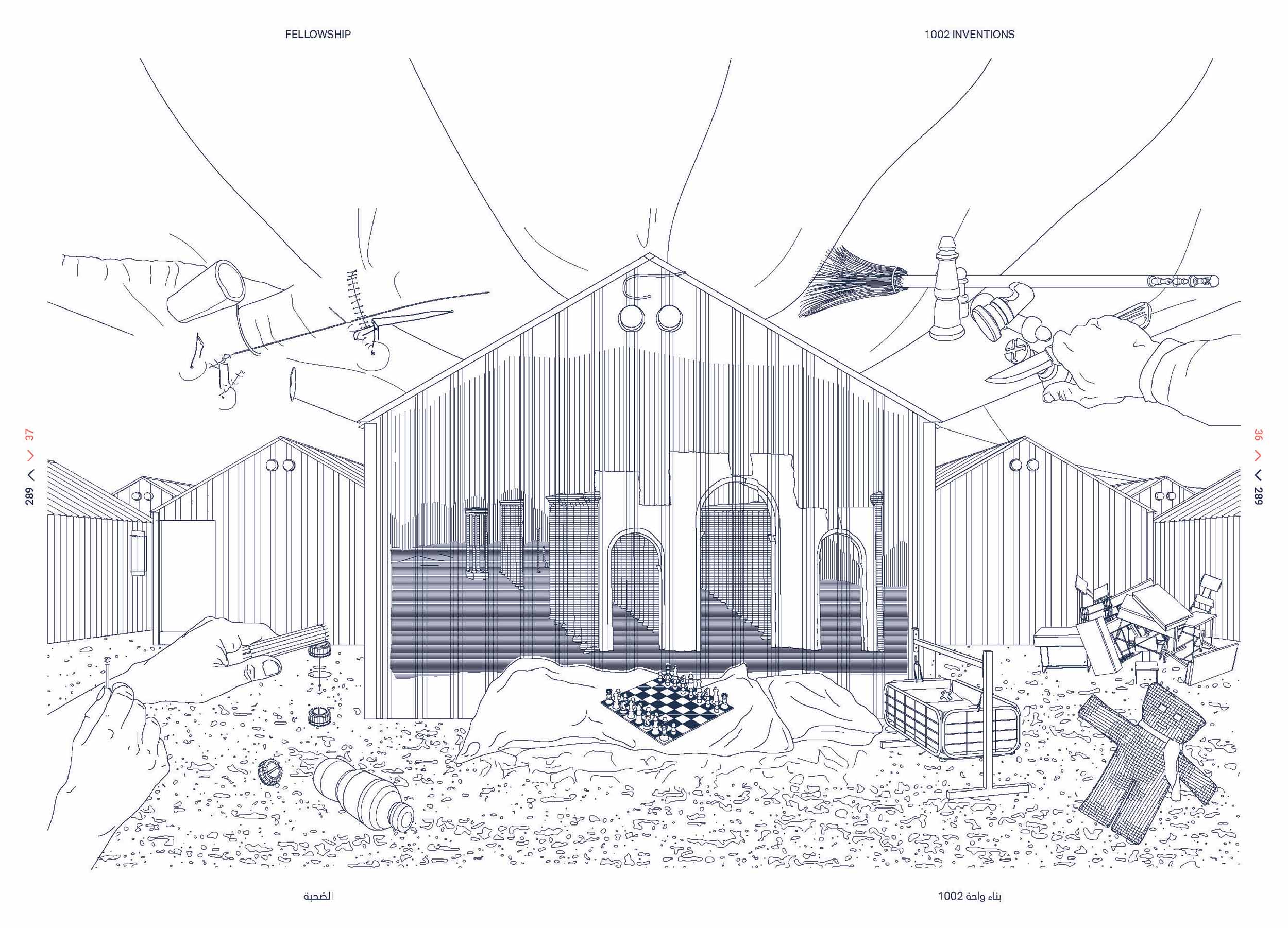
Page from the book Design to Live: Everyday Inventions from a Refugee Camp highlighting the ways in which refugees in Jordan's Azraq Refugee Camp have made the most of limited resources to improve their conditions, creating, as some told the research team, a "life worth living." Edited by Akšamija, Raafat Majzoub, and Melina Philippou, the book was released by MIT Press in October 2021.
Another is UNHCR and various humanitarian agencies; we do reach out and see how we can be further helpful.
And a third target group for our work is the people in the camp themselves. The book is also a record of their life there, a record of their ingenuity, and also of cultural memory, right? And it’s a sense of pride for the kids who worked with us and created poems and texts for it.
I just sent one of the books to a member of Al Azraq Journal team who participated in workshops; he was 14 or 15 at the time, and now he’s 18 or 19. He started studying architecture in Jordan, inspired by these encounters, and then I saw him on Facebook in an airplane, and I’m like, “Where are you going?” “I’m on the way to Germany.” As I found out later, he got smuggled into Germany, through Ukraine. But a friend of his, another young man who worked with us on the book, didn’t make it—he died on the way, drowned, when they were chased on the border somewhere in Eastern Europe. It’s awful—it brings you back to the reality that these people are facing.
The young man who made it to Germany, I FedExed him the book and he was like, “My God, this is the best present I ever had.” But I don’t know what he will do—I hope he will be able to continue studying. In the camps, you have kids dropping out of school because they don’t see a point in going—they think they will never be able to leave the camp. Here you have a kid who actually went on to study architecture, but then he fled from Jordan, because even studying architecture wouldn’t grant him any possibility to work there, probably, because of the politics of hosts and migrants and the lack of access to vocational possibilities.
So it’s just a really complicated set of outcomes, all this work.
Interview edited and condensed.
Explore
Yasmeen Lari: Barefoot Social Architecture Benefitting People and the Planet
The Pakistani architect and humanitarian argues for “barefoot social architecture,” a design philosophy emphasizing co-creation and carbon-neutral materials.
Tillers of the horizon: Projecting public spaces by women in post-conflict Rwanda
Yutaka Sho explores how Rwandan communities are turning petrochemical waste into affordable and high-performance houses.
Anna Heringer: Sustainability=Beauty
The German architect speaks about her love of mud as a building material.

